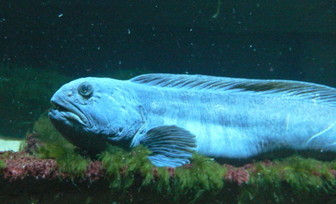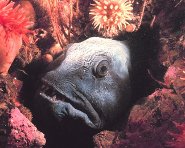Wolf-fish
In spite of its large size the Atlantic wolffish has retained the bodily form and general external characteristics of small blennies .

The Wolf-fish lives in the demersal, oceanodromous, marine, depth range 1 - 600 m , usually 18 - 110 m environment.
The Wolf-fish - Antifreeze and Fangs
 The wolf-fish (Anarhichas lupus) is the largest fish of the Anarhichadidae family. They live on both the west and east coasts of the North Atlantic Ocean, Greenland, Britain, Scandinavia, and Iceland, with the most concentrated populations located in the Gulf of Maine. Also known as the ocean catfish, seawolf, or seacat, the wolf-fish is also the most unique of the family.
The wolf-fish (Anarhichas lupus) is the largest fish of the Anarhichadidae family. They live on both the west and east coasts of the North Atlantic Ocean, Greenland, Britain, Scandinavia, and Iceland, with the most concentrated populations located in the Gulf of Maine. Also known as the ocean catfish, seawolf, or seacat, the wolf-fish is also the most unique of the family.On average, wolf-fish weigh 10 to 40 pounds (4.5 to 18.1 kilograms), and measure up to 5 feet (150 centimeters) long. Wolf-fish are benthic, meaning they live on the ocean floor, and they are found in water that is anywhere between 250 to 1600 feet deep. Rock formations and caves make the ideal home where the solitary wolf-fish spends most of its time, venturing out primarily just to find food.
The most obvious feature of the wolf-fish would be the protruding canine teeth. Behind these fang-like canine teeth are three rows of smaller crushing teeth, with the middle row containing four pairs of molars. There are also smaller serrated teeth that line the fish's throat. Using these teeth and an extremely strong jaw, the wolf-fish crush their prey. Prey includes mussels, starfish, sea clams, crabs and other hard-shelled mollusks. The wolf-fish does not eat other fish, and its only known predator is the Atlantic cod. The wolf-fish also dines on green crabs and sea urchins, whose populations would otherwise increase rapidly and could potentially be harmful to the marine environment.
The large teeth give the fish a very intimidating appearance, but it\'s what you don't see that really sets this fish apart. The wolf-fish produces a type of natural antifreeze that helps to keep their blood flowing and allows them to thrive in such cold waters.
Another unique attribute of the wolf-fish is how they reproduce, along with the large size of the eggs (6.5 mm). Unlike other fish that release their eggs into the open waters before fertilization, wolf-fish eggs are fertilized internally. Spawning generally occurs between November and February. After fertilization, the male acts as the caregiver. He will protect the eggs and newborn wolffish for about four months, until they are strong enough to be independent.
Although not endangered, the wolf-fish is currently a Species of Concern by the National Marine Fisheries Service due to a drastic decrease in population. Over-fishing and recreational fishing have been the major contributing factors to this decrease.
Common names
Almindelig havkat in Danish (dansk)
Anarhichas lupus in Italian (Italiano)
Anarhichas lupus in Spanish (español)
atlantic wolffish in English
Bavosa lupa in Italian (Italiano)
blennie-loup in French (français)
Cat-fish in English
Catfish in English
Gestreifter Katfisch in German (Deutsch)
Gestreifter Seewolf in German (Deutsch)
Gråsteinbit in Norwegian (Norsk)
Havkat in Danish (dansk)
Havskatt in Swedish (Svenska)
Hundfiskur in Faroese (Føroyskt)
Karbonadenfisch in German (Deutsch)
Katfisch in German (Deutsch)
Kêrak in Inuktitut (ᐃᓄᒃᑎᑐᑦ)
Kigutilik in Inuktitut (ᐃᓄᒃᑎᑐᑦ)
KÍrak in Inuktitut (ᐃᓄᒃᑎᑐᑦ)
Kissakala in Finnish (suomen kieli)
Koteletfisk in Danish (dansk)
Lobo in Portuguese (Português)
Lobo in Spanish (español)
loup in French (français)
loup atlantique in French (français)
Loup de l'Atlantique in French (français)
Loup de mer in French (français)
loup marin in French (français)
Lupa di mare in Italian (Italiano)
Lupadi mare in Italian (Italiano)
Merikissa in Finnish (suomen kieli)
Ocean whitefish in English
Peixe-lobo in Portuguese (Português)
Peixe-lobo-riscado in Portuguese (Português)
Perro del norte in Spanish (español)
Pesce lupo in Italian (Italiano)
Qeeraaraq in Greenlandic
Qêraq in Inuktitut (ᐃᓄᒃᑎᑐᑦ)
QÍraq in Inuktitut (ᐃᓄᒃᑎᑐᑦ)
Seewolf in German (Deutsch)
Steinbeißer in German (Deutsch)
Steinbit in Norwegian (Norsk)
Steinbítur in Faroese (Føroyskt)
Steinbítur in Icelandic (Íslenska)
Stribet havkat in Danish (dansk)
Wolf-fish in English
Wolf-fish in Ukrainian (українська мова)
Wolffish in English
Zębacz pasiasty in Polish (polski)
zebacz smugowy in Polish (polski)
Zeewolf in Dutch (Nederlands)
zubatka in Russian (русский язык)
зубатка полосатая in Russian (русский язык)
大西洋狼魚 in Mandarin Chinese
大西洋狼鱼 in Mandarin Chinese


Family : Anarhichadidae
Genus : Anarhichas
Species : Anarhichas lupus
Authority : Linnaeus, 1758
